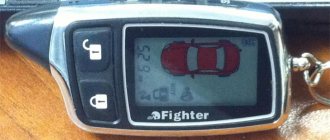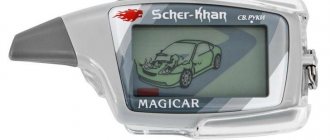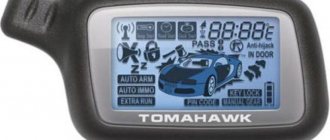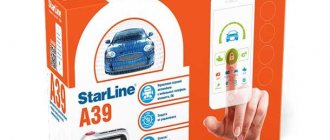Operating instructions A.P.S. 2100
Pay attention to the 3 main components of your APS 2100 security system
: - Key fob transmitter - LED System Status Indicator (LED) - Vale switch
1. Key fob transmitter with a dynamic code The APS 2100 car alarm kit includes two key fobs transmitters with a dynamic code based on the KEELOQ microprocessor. Each time you press the transmitter button, the code will automatically change in random order. Thus, your system is protected from attempts to “intercept” your transmitter code using a code grabber. During operation, a situation may arise when the codes of the key fob transmitter and the main unit of the system become desynchronized (for example, if you press the transmitter button more than 30 times away from the car). In this case, you will only need to approach the car and quickly press the transmitter button twice. There are two buttons on your transmitter key fob: a large left button and a small right button. The functions of these buttons are given below: Large Left Button - Used to arm and disarm the system. Small right button - used for silent arming and disarming of the system, for controlling the output of the 2nd channel, and, together with the Large left button, for arming the system with disabling the shock sensor. Both buttons pressed together control the remote “Panic” mode and enable the Anti-Carjacking anti-theft function. 2. System Status LED (System Status Indicator) The LED informs the vehicle owner about the status of the security system and indicates the zone or trigger that caused the system to activate. 3. Valet switch This switch allows you to temporarily disable the security functions of the system (by switching the system to the Valet service mode). It is also used in conjunction with the ignition key to emergency disarm the system in case of loss of the transmitter, to disable Anti-Carjacking mode, to program system functions and to program new transmitters.
APS 2100 OPERATING MANUAL
1. Installation of the APS 2100
to arm using a transmitter Turn off the ignition, get out of the car and make sure that all doors, hood and trunk are closed.
Press and release the Large Left Transmitter Button once. You will hear the siren confirm once, the parking lights will turn on once and the LED will flash slowly. The system will also automatically lock the car door and block the starter (or ignition). 2. Arming the APS 2100 system by disabling the shock sensor To arm the system by disabling the shock sensor, press and release the Large left button of the transmitter (the siren will give 1 confirmation signal and the parking lights will turn on once) and then press and release within 3 seconds Small right button. The siren will give an additional 1 long confirmation signal and the side lights will turn on for several seconds, confirming that the system is armed, but the shock sensor input is disabled. 3. Bypassing a faulty zone when arming a) If one of the doors, hood or trunk is not closed, or if one of these circuits is faulty, then when arming the system using the transmitter you will hear 3 siren signals (instead of one) and side lights lights will flash 3 times. This will bypass the open or faulty circuit and the LED will flash 2 or 4 times, paused for 30 seconds, indicating the faulty and bypassed circuit (door or hood/trunk, respectively). b) If the shock sensor circuit is faulty, then 5 seconds after arming the APS 2100 system (i.e. after 1 siren signal), you will hear 3 more siren signals and the side lights will flash 3 times. The LED will then flash in a series of 3 flashes, pausing for 30 seconds. c) Once the bypassed circuit during arming is closed or corrected, the system will also immediately arm it. 4. Automatic (passive) arming of the APS 2100 system
1. Turn off the ignition, get out of the car and make sure that all doors, hood and trunk are closed.
Once the last door has been closed, the LED will begin to flash rapidly to indicate that the time is counting down before the system will automatically arm. 30 seconds after the last door has been closed, you will hear 1 siren signal, the side lights will turn on 1 time and the LED will flash slowly. At this point, the system will also automatically lock the car door (if function #2 is enabled) and block the starter (or ignition). If one of the doors, hood or trunk is opened during the 30-second countdown before the system is automatically armed, the LED will turn off and the countdown will be stopped. Once all doors, hood and trunk are closed again, the LED will again flash rapidly and the 30-second countdown will begin again. The automatic arming function (features #1 and #2) is programmable and you can disable it at the customer's request. The programming procedure is described in the “Programmable system functions” section. ATTENTION: In the automatic arming mode, the open or faulty circuit bypass function will NOT work! Since the countdown for automatic arming of the A.PS 2100
begins only after the last door has been closed, if one of the doors, hood or trunk is left open, or if one of these circuits is faulty, automatic arming will not begin. You can, however, arm the system at any time using the transmitter. If only the shock sensor circuit is faulty, 5 seconds after automatic arming, the siren will sound 3 more times, the side lights will flash 3 times and the LED will flash in a series of 3 flashes after a pause for 30 seconds, indicating that this circuit has been bypassed. 2. If you want to temporarily disable the automatic arming function, turn off the ignition and within 3 seconds press and hold the Large Left button of the transmitter until the siren gives one short confirmation signal. After this, the automatic arming feature (or the automatic engine immobilization feature, if this feature is enabled) will be temporarily disabled until the next time the ignition is turned on, regardless of whether the vehicle doors are closed or unlocked.
What does a car enthusiast expect from a security system? Of course, a high degree of protection, a sufficient range of service functions, the possibility of self-installation (configuration) and stable operation. The APS alarm system meets all criteria. It can rightfully be called one of the most successful products on the market of anti-theft systems.
A car owner who decides to become more familiar with the capabilities of this product may be confused by the search engine results for the request Aps. Most likely, the user will be presented with a list of articles about the characteristics of an automatic fire system (APS), but if you use the correct abbreviation (APS), then the necessary information about car alarms of this brand will become available and the motorist will have the opportunity to learn about all the advantages that they promise installation and operation.
Technical characteristics of APS 2300 and APS 2600
Automotive warning systems APS 2300 and APS 2600 are produced under the brand name Sheriff. They are characterized by stable operation and good efficiency in urban mode
What is important for residents of the northern regions, the aps 2300 car alarm and other models from this line have proven themselves in difficult weather conditions, including severe frosts and dampness
APS 2300 and APS 2600 are alarm systems from the same model range. They have a number of common characteristics, which include:
- signal transmission using dynamic code;
- control of two programmable key fobs;
- shock sensor 2 levels;
- starter blocking using a relay;
- “Anti-robbery” function;
- improved Panic mode;
- silent installation of security;
- emergency shutdown and programming with the Valet button;
- control of door locks and direction indicators;
- controlled channel for connecting additional equipment;
- disarming the alarm in two stages and more.
From its predecessor 2300, the 2600 alarm system differs in the presence of several additional functions and a different key fob design, which has an ergonomic shape and looks like a small boomerang. Auto protection provides its owner with expanded opportunities for protection and comfort, while remaining as simple and reliable as all models in this series.
The differences between car alarms aps 2600 and 2300 are described in more detail in the table:
| APS2300 | APS 2600 | |
| Price | discontinued | 33 dollars |
| Dynamic code | + | + |
| Engine lock | Analog relay | Analogue and built-in relay |
| Trigger memory | — | + |
| Power channels | 1 | 2 |
| Shock sensor | Magnetic resonance | piezoelectric |
- Price. The price of the equipment depends on the presence of a siren in the kit, as well as on the place of sale.
- Dynamic code. Protects the alarm system from scanning and code interception. Each time you press the key fob, the system changes the encoding, and attackers will not be able to use the intercepted signal again.
- Engine blocking. If the car thieves disarmed the audible alarm and got inside the car, blocking the unit using a relay will prevent the engine from starting.
- Trigger memory. In case of violation of one or more security zones, the driver will be able to find out exactly where the alarm occurred and find out its possible cause.
- Power channels. Controlled outputs make it possible to connect additional accessories, such as window closers or a pager.
- Shock sensor. The main sensor of the car, which reacts to shocks and vibrations of the car body. It transmits an alarm signal to the system processor, which in turn turns on the siren.
High efficiency of security functions
Manufacturers of APS car alarms relied on the dynamic Keeloq radio channel interception protection code and were not mistaken.
The information that this technology is outdated and that such a security barrier can be easily bypassed using a code grabber (a device designed to decode, remember and repeat an “overheard” code) is just a myth. Only the most unsuccessful implementations of it can be hacked, those used by manufacturers according to the scheme of using one key for all systems of their brand (such unsuccessful technology has nothing to do with Aps).
Another principle applies here: the format of the packet transmitted over the radio channel from the key fob to the system changes with each subsequent press of the button (the alarm system simply discards previously used codes), which means it is impossible to record them and repeat them for subsequent disarming.
Similar technology is used for all APS alarms, regardless of price category and model (be it aps1500, aps 3900, aps 5100 or aps 9000).
Budget models: functionality
Another secret of the popularity of this brand of alarms lies in the optimal set of options that Aps security systems can boast of. The car enthusiast has the right to choose which of the functions he wants to get for his money. The choice of models is huge, the options are different. Some will prefer a sufficient minimum:
- one-way communication (if there is an attempt to steal, only the sound siren will work, no other signals will be sent - an alert to the key fob or phone);
- central locking control (automatic unlocking/locking of doors using the control panel);
- service mode (Valet button, necessary for binding, reprogramming the key fob and emergency disarming);
- “panic” mode (the ability to turn on sound and light alarms from the remote control if necessary, for example, to attract attention or search for a car in the parking lot);
- silent arming/disarming (the alarm will be turned on or off without a single sound);
- LED status indicator (LED is a kind of beacon that allows you to understand whether the security mode is on or off).
If these features are enough and overpaying for more functionality is not part of the car enthusiast’s plans, then you should pay attention to the following models:
APS 2500, 3700, 2550, 3900, aps 2900 (the operating instructions will give a clear idea of the list of specific functions that the machine owner can use after installing these aps alarms).
Business class models: extended optional set
APS alarms, which are one step higher, can please their owner with a wider range of service functions. They also have useful options such as:
- Feedback . The system reports an attempted theft not only with an audible siren, but also with a message on the key fob or phone.
- Anti-Carjacking mode. Blocks the engine during a robbery 30 seconds after pressing the button (with the ignition off).
- Anti-Hi-Jack mode. Blocks the engine while driving. Provides two options:
- passive (relevant when the car owner is driving and an attacker is trying to take possession of the vehicle from the passenger seat);
- active (used if the car is already controlled by an attacker, but it is still within the range of the key fob).
- Automatic engine start. The engine starts working under certain conditions: at a specific time, at a specific air temperature, after a specific time interval (autostart without an alarm will be more expensive).
- Features that enhance your comfort. One of the most useful options is remote control, including:
- window lifters;
- door, hood, trunk locks;
- “polite lighting” of the interior;
- direction indicators.
This is just a brief overview of the useful alarm options in this line (aps 2100, 2800, 5300, 2700). Each model is a set of the above features + bonus options. So, for example, the aps 7100 two way can also be pleased with the passive engine blocking mode, and the aps 2300 with automatic re-arming.
Captivating factors: affordable installation and connection
What else makes APS alarms attractive to car enthusiasts? The opportunity to save not only on their cost, but also on installation and connection. It is quite possible to carry out this event yourself (you do not need to spend money on paying professionals).
All you need is information about the correct localization of system elements and a detailed connection diagram. To help the new owner of an APS alarm system, the operating instructions are necessarily included in its package.
For motorists who have decided to independently install an APS alarm, useful information from the relevant sections of this manual regarding the following points:
- Location of system elements. The basic principle of the location of the alarm components: away from heating parts and places not protected from moisture (central unit under/behind the instrument panel, antenna on the windshield, siren under the hood with the horn facing down, more details in the installation manual).
- Connection. The first rule (it’s golden and reliable) is to act according to the scheme given in the instructions, without bypassing the manufacturer’s recommendations covered there, and everything will work stably and for a long time. No special knowledge is required, there are simply no incomprehensible moments (everything is described clearly in the instructions: red wire to green wire, yellow to black wire), it is accessible and understandable, it is impossible to make a mistake.
That's all. The APS alarm system is installed, all that remains is to configure the necessary parameters.
Aps4 immobilizer equipment - what devices does the security system include?
A car immobilizer differs from a standard alarm system in terms of configuration, price, functionality and installation method. If a standard alarm system includes many modules, blocks and wires, then the aps4 immobilizer includes the following components:
- main electronic immobilizer system unit;
- code reader, which is built into the car dashboard;
- two black coded keys – for standard operation of the security system;
- one red code key - to put the security immobilizer in service mode;
- user manual and security system installation guide.
This immobilizer for VAZ works on a special principle and in order for it to perform its functions properly, the security device first undergoes a learning process.
The immobilizer has a rather inconspicuous appearance; it must be installed inside the vehicle; the main unit has a hermetic coating, which allows it to avoid moisture and withstand exposure to low and high temperatures.
It’s as simple as shelling pears: we program the protection system
The initial task is to link the key fob (until the control panel is linked to other alarm elements, there can be no talk of 100% protection or convenient operation). Working step by step, you can activate the key fob on your own in a couple of minutes.
A detailed algorithm of actions required to bind a key fob (using the example of aps 1350, relevant for all models) looks like this:
- Step 1 . Turn the ignition on and off 5 times (system behavior: sound signal - 5 short sirens, light signal - 5 short flashes).
- Step 2. We move the “Valet” service switch to the “ON” position, change it to the “OF” position, repeat the action 5 times (system behavior: no change).
- Step 3. Press the large left button of the key fob (system behavior: no later than 10 seconds after the system is notified of the transition to the programming mode with 5 sound and light signals, followed by 1 short sound signal, means that the key fob has been entered into the security memory).
- Step 4. We repeat action number 3 for each subsequent key fob (system behavior: each memorization of a new element is accompanied by a corresponding number of short sound signals, for example, three – the third key fob is recorded, two – the second remote control is recorded in memory, one – the first key fob is “registered”).
- Step 5. We are waiting to exit the programming mode; 10 seconds after registering all key fobs, the alarm will automatically turn off (system behavior: 5 short alarms).
The secondary task comes down to programming (configuring) the available functions. Everything is simple here: you just need to act strictly according to the instructions and everything will work out!
Joke from AvtoVAZ
Important! When disassembling the immobilizer yourself, pay attention to the markings of its boards. The fact is that the case from APS-4 may contain a board from the 6th series. This is another, another cruel joke from AvtoVAZ
This is another, another cruel joke from AvtoVAZ.
VEHICLE ANTI-THEFT SYSTEM (APS)
The car is equipped with an APS-4 car anti-theft system (immobilizer), consisting of a control unit, a system status indicator and code keys.
The immobilizer is an electronic unit that prevents unauthorized engine starting, opening the necessary electrical circuits and works in conjunction with the electronic engine control system.
The immobilizer goes into security mode automatically when the ignition is turned off.
Checking the activity of the anti-theft system
First of all, make sure that the anti-theft system is connected and inactive. To do this, close all the car doors except the driver's door, get into the car and close the driver's door. The interior lamp should continue to light after closing the driver's door for another 12 seconds, and then go out smoothly. Turn on the ignition, the system status indicator LED should light up and stay lit while the ignition is on. In this case, you can proceed to the procedure for transferring the anti-theft system to the active state, i.e. carry out the so-called “training” of the system with code keys, which then become individual for each anti-theft system.
If, when the ignition is turned on, the system status indicator LED blinks at a frequency of 2 times per second, this means that the anti-theft system of your car has already been switched to an active state.
Disarming the immobilizer
To disarm the anti-theft system and start the engine, do the following.
1. Open and close the driver's door or turn on the ignition. In this case, the system goes into the “reading” mode of the key code, and the system status indicator LED on the instrument panel begins to blink at a frequency of 2 times per second. If the transition to the “reading” mode is carried out by turning on the ignition, the buzzer will emit a short sound signal.
2. In the “reading” mode, which lasts 1.5 minutes if the door was manipulated, or 10 seconds if the ignition was turned on, you should bring “your” working key to the indicator. After the system reads and recognizes the key code, the LED goes out and the buzzer emits a double beep. When the LED turns off, the engine can be started.
3. Turn on the ignition, the LED will light up briefly and go out, the engine should start.
The anti-theft system switches to security mode automatically after turning off the ignition and depends on the situation and the actions of the driver. If the driver’s door did not open or was open and not closed, then arming occurs after 5 minutes; If the driver's door was opened and closed, then arming occurs 30 seconds from the moment the door is closed.
In all cases, 15 seconds before arming the system, the buzzer starts beeping at an accelerating pace. If arming is not desired, then you must turn the key to the “ignition” position.
If, when you turn on the ignition, the system status indicator LED does not light up, but flashes at a frequency of 1 time per second for 20 seconds, this means the following:
1) there is no electrical connection between the engine control controller and the immobilizer unit. Check the connection in the engine control system harness;
2) the engine control controller was previously “trained” with code keys from another immobilizer unit. The engine will not start. Contact a service station;
3) if, when the ignition is turned on, the LED does not light up and blinks at a frequency of 5 times per second for 20 s, this means an error in the immobilizer unit. If this flashing does not stop even when the ignition is turned on again, you must contact a service station.
Immobilizer “learning” procedure
If you are convinced that the anti-theft system is in an inactive state, you can proceed to the procedure for “learning” (coding) code keys. To do this, follow these steps:
1. Turn on the ignition. The LED of the system status indicator should light up with a steady, non-flashing light no later than 5 s.
APS: not perfect yet, but aiming for perfection
Malfunctions of any alarm system are an inevitability that every vehicle owner may encounter. Unfortunately, the questions: how to turn off the Starline, Pharaoh, Panther, APS alarm systems without a key fob are still relevant. Perhaps in the future the search bar of browsers will not be loaded with similar requests from car owners who have installed security system data on their car, but today they do exist.
The main problem with this brand of security systems lies in the fact that the APS alarm does not respond to the key fob. The reason for this phenomenon may be:
- insufficient charge of the power supply of the control panel, pulses sent via the radio communication channel are not able to forward commands encrypted in packets (the old battery in the key fob is dead, the signal strength has decreased, it is time to replace the power source)
- resynchronization between system elements installed on the machine and the control panel (you can return the relationship by rewriting the key fobs, using the Valet service button; step-by-step guidance on how to implement this activity should be found in the operating instructions).
To summarize the above: APS alarms are the most comfortable and effective vehicle protection against theft, one of the best products in this market segment. So is there any point in looking for something better?
The car security system called APS 2100 was created in 2001 and is not currently available.
This alarm system was very popular among residents of the CIS countries and can be found on many cars of the domestic automobile industry.
"Doubles" of the system
Cars of different brands are equipped with similar systems that have different names. Yes, A.S.R.
- This is the prerogative of cars from the German brands
Mercedes , Audi
and
Volkswagen
.
DSA
Opel cars .
TCS
Toyota
vehicles .
ASR, like other twin systems, is part of the stability control system known as ESP
.
APS 2100 – simple and effective vehicle protection
The main feature of the aps 2100 car alarm is its reliability in the fight against burglary attempts and car theft. The one-way system works flawlessly. It instantly notifies the vehicle owner of possible danger and sounds an alarm.
Autoprotection also has other functions, the main of which are:
- Unlocking and locking doors using the remote control.
- Service mode. Using the Valet button hidden in the cabin, you can remove the alarm in emergency mode and program some additional functions.
- Panic mode, which allows you to find a car in a crowded parking lot.
- Anti-theft function, which gives an alarm signal when the engine is on, and more.
The developers also provided the APS 2100 with some additional features that the owner can program individually.
Classification
Let's consider the following types of fire trucks depending on their purpose: main, special and auxiliary.
Each type of fire truck is designed to perform separate functions during fire fighting:
Basic
They are used to transport firefighters, water or other fire extinguishing agents to the place of emergency (fire) to extinguish the fire and perform tasks as intended. In turn, this group is divided into cars:
1. General purpose – for extinguishing fires in the residential and industrial sector of cities and towns (fire tankers, fire pumps, pump-hose vehicles, first aid fire trucks);
PAs of general use are usually classified as:
- Fire tankers (ATs);
- Pump-hose vehicles (AP)
- First Aid Vehicles (ATV)
- A car with a high pressure pump (HP)
- Fire and rescue vehicles (APS, PSA).
2. Vehicles for intended use, adapted for extinguishing fires at production facilities in the production of which substances may be used, the extinguishing of which must be carried out with special fire extinguishing compounds, departmental facilities of the chemical, oil production and oil refining industries (vehicles for air-foam extinguishing, powder, gas-water, combined extinguishing, pumping station, etc.).
PA intended use is usually referred to as:
- Aerodrome vehicles (AA);
- Powder extinguishing vehicles (AP);
- Foam extinguishing vehicles (FEV);
- Combined extinguishing vehicles (ACT);
- Gas extinguishing vehicles (AGV);
- Gas-water extinguishing vehicles (AGVT);
- Automotive pumping stations (VPS);
- Firefighting foam lifters (FPR).
Special
Serve to provide special work during fire (ladders and articulated lifts, gas and smoke protection service vehicles, smoke removal, etc.)
Special fire trucks include:
- Fire ladders (AL);
- Articulated car lifts (APC);
- Telescopic car lifts with stairs (TPL);
- Ladders with a tank (ALTs);
- Articulated car lifts with tank (APKTs);
- Emergency vehicles (ASA);
- Waterproof vehicles (AWP);
- Communication and lighting vehicles (ASO);
- Vehicles of gas and smoke protection service (AG);
- Smoke extraction vehicles (SEVs);
- Hose Automobiles (AR);
- Staff vehicles (AS);
- Fire Automotive Laboratories (FAL);
- Diagnostic vehicles for fire fighting equipment (ADVT);
- Base vehicle of the gas and smoke protection service (ABG);
- Technical service vehicles (APTS);
- Heating vehicles for fire fighting equipment (AOPT);
- Fire compressor stations (FCS);
- Fire-fighting vehicles (AT);
- Firefighting operational service vehicles (AOS).
Auxiliary
These are vehicles that include vehicles for servicing fire trucks, delivering personnel, fire, special and rescue equipment of the Ministry of Emergency Situations (fuel tankers, mobile repair shops, laboratories, buses, fuel trucks, etc.)
Alarm equipment and price
The APS 2100 kit includes the following items:
- Bell with tone control
- shock sensor with microphone
- two plastic keychains
- starter blocking relay
- system installation kit
- instructions for connecting car alarm aps 2100
Since this model is not produced by the manufacturer, only its analogues can be purchased in stores. The closest in terms of its range of capabilities would be the APS-2700 alarm system, which is sold under the Sheriff arch. The cost of such a one-way alarm is approximately $26-30.
APS 2100 – 5 main advantages and disadvantages
| Advantages | Flaws |
| 1. Reliable performance. The APS 2100 rarely malfunctions. It provides a stable signal and good communication with the car | 1. One-way communication. When the alarm is triggered, the aps 2100 car alarm key fob does not receive a notification |
| 2. Ease of use. A two-button key fob and a minimum number of functions allow anyone to control the system without any problems. | 2. Outdated functionality. APS 2100 is not capable of providing many modern functions, such as remote engine start, window control and more. |
| 3. Easy to install. The aps 2100 car alarm connection diagram allows you to easily install it on your car yourself. | 3. Short signal reception distance. The alarm responds to remote control signals at a distance of no more than 30 meters. |
| 4. Durability. Many APS 2100 systems have served on cars for about 10-15 years without causing any complaints from owners | 4. Lack of spare parts. If one or another element breaks, it may be difficult to replace it. |
| 5. Versatility. The alarm system is installed on any car, including carburetor VAZs. | 5. Excessive sensitivity of the magnetic resonance shock sensor. |
TYPES OF FIRE ALARMS
At the moment, many models and modifications of automatic fire alarms are used. The main differences are in the transmission method and information content of the transmitted signal. In addition, there is a difference in technical characteristics and algorithms for processing information coming from detectors.
Addressless, threshold APS
Detectors connected in series into one loop are connected to the control panel. Threshold type fire detectors are triggered when the limit value of a certain parameter is exceeded: temperature, presence of combustion products, etc.
All fire alarm detectors are connected to one low-current electrical line - a loop. Activating at least one device opens the loop (or changes its capacitive parameters) and activates an alarm.
This system is suitable for installation in small areas with a simple layout - a medium-sized room with a low probability of fire.
| Advantages | Flaws |
| Easy installation | Low information content |
| Easy maintenance | Additional measures are needed to locate the exact location of the fire |
| Affordable cost of equipment | The largest number of false alarms among all types of alarm systems |
| Device compatibility* | It is impossible to check the functionality of the detectors |
* Typically, threshold fire detectors are triggered when the circuit is opened, so the manufacturer of the equipment is absolutely unimportant for the control panel.
ADDRESS-SURVEY APS
More expensive addressable detectors are used as fire detectors. Each of them is connected to the control panel using a ring circuit. The detectors are triggered when a threshold value is exceeded; the operator can determine the location of the fire.
The control panel also periodically polls peripheral equipment to determine its operability. If a breakdown is detected or there is no return signal, an alarm message is displayed on the control panel with information about the failed device.
Addressed survey APS is recommended for use for medium-sized objects with a complex layout.
Advantages:
- quick determination of the exact location of the fire;
- ease of installation - all sensors are combined into one ring structure;
- relatively small amount of consumables and quick installation;
- monitoring the operating status of peripheral devices;
- ease of maintenance and prompt restoration of system functionality after failure.
Disadvantage: high cost of equipment and complexity of setup
ADDRESSABLE ANALOG FIRE ALARM
The control panel continuously polls peripheral equipment. Detectors transmit information about the current value of the controlled parameter.
Based on the underlying algorithm, several indicators are compared, both relative to the boundary value and in the dynamics of changes. This principle of operation minimizes the number of false alarms and at the same time guarantees the identification of the source of fire at the earliest stages.
As in the previous type of fire alarm, the operator immediately receives information about the location of the fire, and peripheral devices are constantly tested for performance.
Considering the high cost and complexity of setting up equipment, addressable analogue fire alarms are installed at facilities with the most stringent fire safety requirements.
| Advantages | Flaws |
| Minimum number of false positives | The most expensive equipment of all available systems |
| High speed of detection and positioning accuracy of the fire source | High labor intensity and installation cost |
| Constant monitoring of equipment performance | Complexity of commissioning and further maintenance |
RADIO CHANNEL
It is one of the varieties of the addressable analogue fire alarm system and has the same operational characteristics and a similar principle of operation. The difference lies in the method of transmitting information from peripheral devices to the control panel - via a radio signal.
Such systems are the most expensive and their use is justified only in cases where it is impossible to lay cable routes: historical buildings, museums, premises with luxury renovation, etc.
Typical APS 2100 faults
Malfunctions of the APS 2100 alarm system are rare. They are mainly due to a long service life and occur due to broken contacts and lack of insulation on the wires.
Let's look at the most common problems with the aps 2100 car alarm and troubleshooting methods:
1. The alarm does not respond to the key fob
Possible causes of the malfunction:
Used batteries
- The control panel fell into the water
- Faulty antenna on the control unit
- The key fob does not sync with the central module
Ways to solve the problem: if the problem is not in the batteries and the key fob does not fall into the water, you need to rewrite it in the unit’s memory. How this is done is described in detail in the instructions. If this does not help, then the receiver antenna or other parts of the system have failed. You can correct the situation by contacting the service center.
2. False positives.
Possible causes of the malfunction:
- The sensitivity of the shock sensor is set too high
- The sensor mount has come loose
Workarounds: The sensor on the APS 2100 has a built-in microphone. If it reacts to loud sounds, you need to adjust it using the regulator on the body. Sometimes, after long use, the sensor mounts may become loose and it will give false signals. In this case, it is necessary to firmly secure the device under the hood.
Video - Emergency shutdown of APS KeeLoQ 2100 signaling
How to use our instruction site OnlineManuals.ru
Our goal is to provide you with quick access to the contents of the manual for the APS 2100 car alarm. Using online viewing, you can quickly view the contents of the manual and find a solution to the problem with the APS 2100 car alarm.
For your comfort
If flipping through the APS 2100 car alarm user manual directly on the website is not very convenient for you, there are two possible solutions:
• Full Screen View - Easily view the user manual (without downloading it to your computer), you can use full screen view. To view the user manual for the APS 2100 car alarm in full screen, use the “Open in Pdf-viewer” button. • Download to computer – You can also download the APS 2100 car alarm manual to your computer and save it in files.
Many people prefer to read documents not on a screen, but in a printed version. The option to print the user manual has also been provided on our website and you can use it by clicking on the “print” icon in the Pdf viewer. There is no need to print the entire APS 2100 car alarm manual; you can select only the necessary pages of the instructions.
Self-connection of APS 2100
The aps 2100 car alarm connection diagram is included in each kit. With the help of this manual, even a driver who has never done this before can perform the installation.
To successfully carry out installation, you must act in accordance with the instructions. In this case, it is necessary to take into account the following nuances:
- install all elements in places where moisture does not enter
- the central unit, sensors and other parts must be securely mounted on a hard surface, as they are susceptible to constant vibration
- The wiring must be connected into bundles and securely fastened to the body
- It is advisable to install the Valet service button in an inconspicuous place, since attackers know how to disable the aps 2100 car alarm using this key
- Connect wires only in accordance with the diagram, where each wire is connected to the same color.
After all the parts are installed and the wires are connected, the system is configured. The instructions describe in detail how to connect the aps 2100 car alarm. By doing everything in the correct sequence, you can set up the alarm in just 10 minutes.
Instructions
You can learn how to use the APS 9000 car alarm from the instructions that come with each kit. From this manual you will learn:
- How to use standard security functions
- How to manage autorun
- How to program additional security features
In addition, the instructions contain a step-by-step guide for installing auto protection and its connection diagram. By strictly following the manufacturer’s instructions, operating the alarm is easy and comfortable, and even a non-professional can connect it independently.
| Video - the door does not close or open on the alarm | Video - Alarm. How to disable it yourself |











